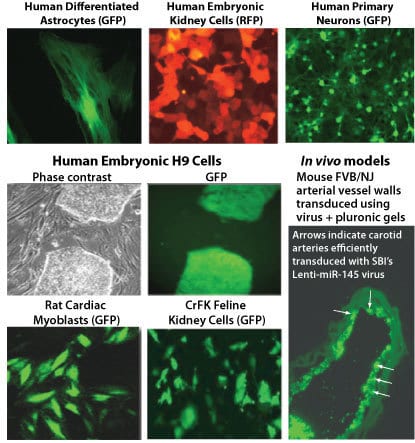pPACKH1 HIV Lentivector Packaging Kit
- Effectively leverage the powerful lentiviral transduction platform with SBI’s optimized HIV-based and FIV-based packaging systems
- Easily generate high-titer lentiviral preparations
- Efficiently deliver most third-generation lentivector expression constructs
-
Successfully reach:
- A wide variety of mammalian cells with VSV-G pseudotyped lentiviral particles
- A broad range of cell types including dividing and quiescent cells, primary cells, stem cells, neuronal cells, endothelial cells, and more
Products
| Catalog Number | Description | Size | Price | Quantity | Add to Cart | |||
|---|---|---|---|---|---|---|---|---|
| LV500A-1 | pPACKH1 HIV Lentivector Packaging Kit | 10 Transfections | $615 |
|
||||
| LV510A-1 | pPACKH1-XL HIV Lentivector Packaging Kit | 25 Transfections | $1339 |
|
||||
Overview
Overview
Produce high-titer lentivirus with this HIV-based Lentivector Packaging Kit
Designed to efficiently package most third-generation lentivectors, the pPACKH1 HIV Lentivector Packaging Kit makes it easy to deliver and express lentiviral constructs in a wide-range of mammalian cells.
- Effectively leverage the powerful lentiviral transduction platform with SBI’s optimized HIV-based and FIV-based packaging systems
- Easily generate high-titer lentiviral preparations
- Efficiently deliver most third-generation lentivector expression constructs
- Successfully reach:
- A wide variety of mammalian cells with VSV-G pseudotyped lentiviral particles
- A broad range of cell types including dividing and quiescent cells, primary cells, stem cells, neuronal cells, endothelial cells, and more
The pPACKH1 Packaging Plasmid Mix consists of three plasmids that produce all the structural and replication proteins needed to transcribe and package an RNA copy of the expression lentivector into recombinant, VSV-G-pseudotyped lentiviral particles. Just co-transfect the pPACKH1 Plasmids and your lentivector construct into 293TN cells or other lentiviral production cells, isolate virus particles, and transduce into target cells. Upon transduction, the lentivector construct becomes stably integrated into the genome of the target cells for long-term expression of genes, miRNAs, shRNAs, etc.
References
How It Works
Supporting Data
FAQs
Documentation
Citations
Related Products
Products
| Catalog Number | Description | Size | Price | Quantity | Add to Cart | |||
|---|---|---|---|---|---|---|---|---|
| LV500A-1 | pPACKH1 HIV Lentivector Packaging Kit | 10 Transfections | $615 |
|
||||
| LV510A-1 | pPACKH1-XL HIV Lentivector Packaging Kit | 25 Transfections | $1339 |
|
||||
Overview
Overview
Produce high-titer lentivirus with this HIV-based Lentivector Packaging Kit
Designed to efficiently package most third-generation lentivectors, the pPACKH1 HIV Lentivector Packaging Kit makes it easy to deliver and express lentiviral constructs in a wide-range of mammalian cells.
- Effectively leverage the powerful lentiviral transduction platform with SBI’s optimized HIV-based and FIV-based packaging systems
- Easily generate high-titer lentiviral preparations
- Efficiently deliver most third-generation lentivector expression constructs
- Successfully reach:
- A wide variety of mammalian cells with VSV-G pseudotyped lentiviral particles
- A broad range of cell types including dividing and quiescent cells, primary cells, stem cells, neuronal cells, endothelial cells, and more
The pPACKH1 Packaging Plasmid Mix consists of three plasmids that produce all the structural and replication proteins needed to transcribe and package an RNA copy of the expression lentivector into recombinant, VSV-G-pseudotyped lentiviral particles. Just co-transfect the pPACKH1 Plasmids and your lentivector construct into 293TN cells or other lentiviral production cells, isolate virus particles, and transduce into target cells. Upon transduction, the lentivector construct becomes stably integrated into the genome of the target cells for long-term expression of genes, miRNAs, shRNAs, etc.



